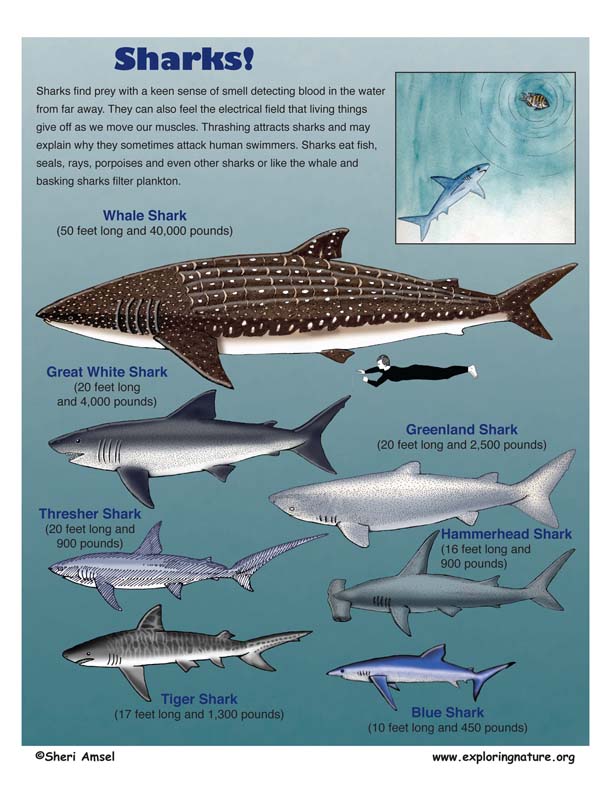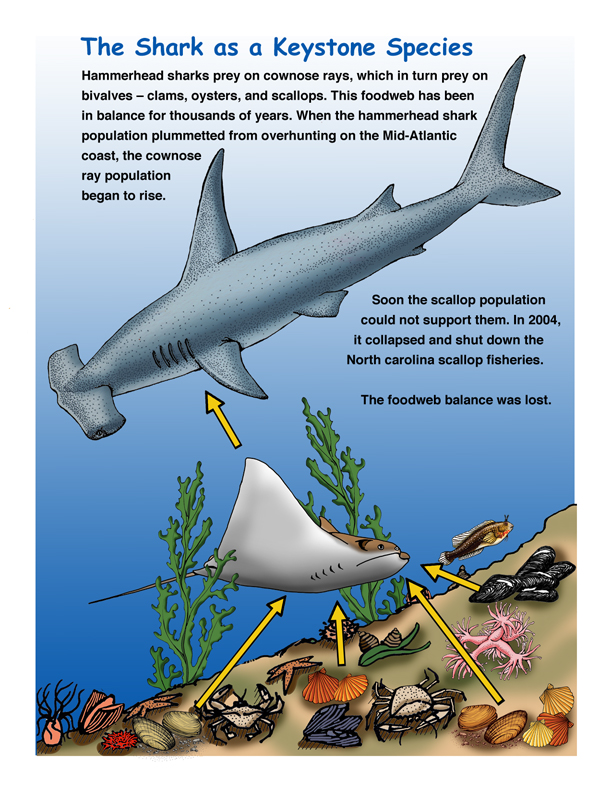

Sharks are not bony fish, like a tuna, but in a group of cartilaginous fish. This class, called Chondrichthyes, also includes skates and rays. Here are their traits:
Sharks are well adapted for their many ocean habitats from the Arctic Greenland shark to the many species prowling the tropics. Some are built like torpedoes, streamlined for speed, like the blue shark. Some have color patterns that help them blend in while approaching prey – darker above and lighter below, like the hammerhead. This camouflage from above blends with the dark ocean below. From below, they blend with the lighter surface above. Others have colors and patterns that match their habitat like the tiger shark’s dappled pattern.
Sharks come in all sizes from the massive whale shark at 50 feet long and 40,000 pound to the dwarf lanternfish – at just 6 inches. They are hunters with rows of sharp teeth and powerful jaws, like the great white shark. Some, like the thresher shark, have long tails to herd fish together for feeding. Sharks find prey with a keen sense of smell detecting blood in the water from far away. They can also feel the electrical field that living things give off as we move our muscles. Thrashing attracts sharks and may explain why they sometimes attack human swimmers. Sharks eat fish, seals, rays, sea turtles, porpoises and even other sharks or like the whale and basking sharks filter plankton.
Shark populations have shrunk to less than a quarter of what they once were because of overfishing. Recent evaluations of fishing practices estimate that more than 100 million sharks are killed every year. This is especially alarming in a species like the shark that grows slowly and does not breed for the first ten years of its life. Even after they begin reproduction, some species, like the thresher shark, only give birth to a half dozen young. This makes recovery from overfishing more difficult.
Much of shark hunting is not for food, but for the development of medical treatments. Shark cartilage and other body parts have been used to treat everything from arthritis to cancer. Unfortunately, there is no scientific evidence to date that any shark products are effective in treating any medical condition.
Sharks play an important role in ocean ecosystems. They are apex predators. This means that they are at the top of their food web and are rarely prey themselves – expect to humans. As predators, they play a role in keeping their prey populations healthy by capturing the slower, weaker fish, turtles, manatee, dolphins, etc. Many are also considered keystone species because of their importance in maintaining a balance in their food webs.
An example of this is the tiger shark. Whether in their habitat on the Great Barrier Reef in Australia or along the coasts of Hawaii, the tiger shark hunts sea turtles. Sea turtles, in turn, eat the seagrass found in shallow coastal waters. Seagrass beds are vital protective habitat for fish and shellfish. If the seagrass beds are overgrazed, the living thing hiding in them becomes visible and more vulnerable to predation. This is what happens when the shark populations decrease. In truth, it is not just sharks eating turtles that keeps the ecosystem in balance. Just the patrolling of sharks in the seagrass beds as they look for prey helps keep the sea turtles moving so they do not overgraze one area.
Sadly, this phenomenon has already been proven in places like Bermuda and along the coastlines of the Indian Ocean, where shark populations have declined and sea turtle populations have risen and entire seagrass beds have disappeared as well as the fish and shellfish along with them.
Another closer to home example of this is happening along the U.S. Mid-Atlantic coast. Here the decline of sharks has been linked to the rise in the population of cownose rays. This ray preys on bivalves – clams, oysters, and scallops. Their increased demand for food resulted in the collapse of the bay scallop population, which in turn shut down the North Carolina scallop fisheries in 2004. This illustrated just one direct connection between the importance of sharks to humans. This pattern of decreased shark populations, increased ray populations, and decreased scallop fisheries has been seen in other regions like the Northwest Atlantic, Chesapeake Bay and Belize, Central America.
Unless shark populations can be regulated and protected, we may see many more food webs disrupted by the loss of their apex predator.
Sharks - Read and React
1. How are sharks different from fish, like tuna or trout?
2. Name three physical traits that help sharks in their ability to be effective hunters and predators:
3. Name two reasons why sharks are not recovering from overfishing:
4. In a food web of hammerhead sharks, cownose rays and scallops, how does the shark keep the balance?
5. If the food web described in #4 is disrupted by the sharks declining from overfishing, how would this affect local scallop fisherman?
More About Sharks:
Classification of Sharks and Rays (Older Students)
Classification of Sharks and Rays (Younger Students)
Related Activity:
Blue Shark Drawing Lesson
Stingray Drawing Lesson
Shark Word Search
Sharks Hidden Picture and Naming
Related Visual Aid:
Shark at the Aquairum Movie
Related Testing and Assessment:
Sharks Multiple Choice Quiz
Sharks - Name Them
When you research information you must cite the reference. Citing for websites is different from citing from books, magazines and periodicals. The style of citing shown here is from the MLA Style Citations (Modern Language Association).
When citing a WEBSITE the general format is as follows.
Author Last Name, First Name(s). "Title: Subtitle of Part of Web Page, if appropriate." Title: Subtitle: Section of Page if appropriate. Sponsoring/Publishing Agency, If Given. Additional significant descriptive information. Date of Electronic Publication or other Date, such as Last Updated. Day Month Year of access < URL >.
Amsel, Sheri. "Sharks!" Exploring Nature Educational Resource ©2005-2024. December 13, 2024
< http://exploringnature.org/db/view/Sharks >

